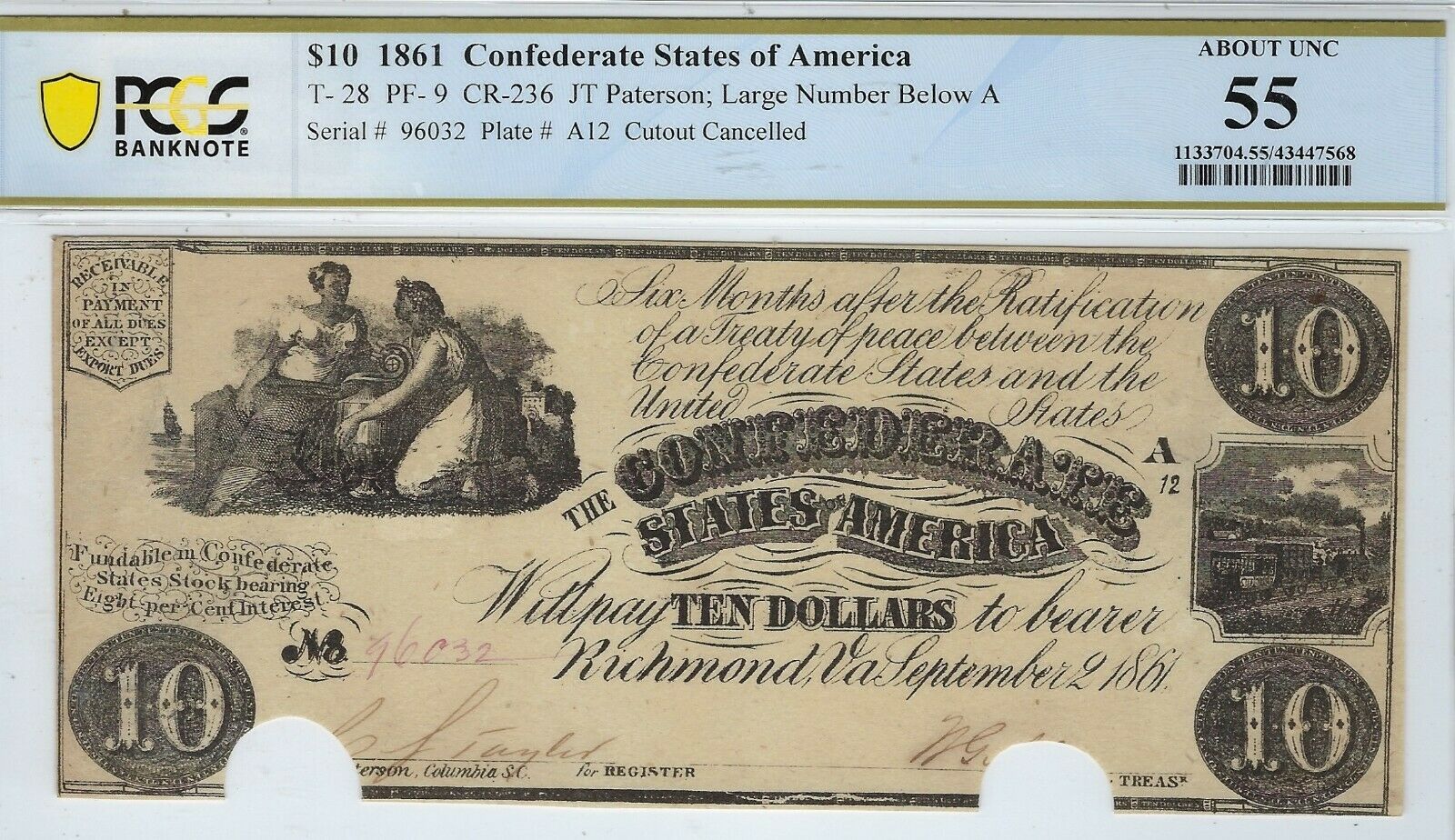-40%
T-28 PF-9 1861 Confederate Paper Money - PCGS-B About Uncirculated 55!
$ 0.52
- Description
- Size Guide
Description
T-28 PF-9 1861 CSA Paper Money.Ceres and Commerce with an urn. 1830s locomotive to the right. Issued from January 23, 1862 through December 13, 1862. J.T. Paterson, Columbia, S.C. at left. Large number below A in the plen with no period following.
Serial number 96032. Plen A12.
PCGS Banknote grading About Uncirculated 55! Cut-out canceled. Old Bradbeer attribution number penciled on the back - interesting history to the note. Great color and trim for the type!
Genuine.
This is a commonly encountered Hoyer and Ludwig product; a lower quality note printed in late 1861. The work to continue printing this type was then passed on to J. T. Paterson. This type replaced the T-27. At left are two females, one representing Ceres, Goddess of Agriculture, holding an urn and the other Commerce. At right is a train of railroad cars. This note was “Receivable in payment for all dues except export dues and fundable in Confederate States stock bearing 8% interest six months after the ratification of a treaty of peace between the Confederate States and the United States.”
This type comes on lower quality paper, which did not wear very well. It was produced on a plate of eight notes, which were plate lettered-numbered A-9 through A-16. The T-28 PF-11 on rare CSA block letter watermarked paper is one of the old time great rarities.
This is a common type in all grades except Choice Very Fine through Choice Uncirculated.
A note about 3rd party grading. PCGS and PMG do a good job putting a floor on quality within a grade range and have become proficient in detecting repairs (though occasionally they miss something, or see something that is not there, as we all can).
Notes housed in Net or Apparent holders have a wide range of quality from very nice (in rare cases may be nearly choice) to dogs with major problems, so each needs to be evaluated on their own.
However, PMG and PCGS focus on technical grading due to circulation and damage and do not have a mechanism for evaluating condition or eye appeal - whether a note is average, better than average, choice or gem for the grade based on its color, trim and margins. The exception to this are slabbed notes of New or Uncirculated grades to some degree. This is important as Very Fine, Extremely Fine or AU notes can have a wide range of values depending on these factors not reflected in the slab grade. A fully framed Confederate or obsolete note is worth considerably to a lot more than one that is trimmed into the margin for the same grade. Likewise, color is important. These factors can affect the value of a note by 50%, 2-1 or even 3-1, e.g., an AU 58 (PPQ or not) T-20 1861 CSA note trimmed into the margin is worth between 0 and 0. The same grade, AU 58 (PPQ or not), with a full frame and good color/inking is worth something like 0 to 00 depending on eye appeal. I will continue to use the terms plus for above average, choice and gem to mean varying degrees of superiority of condition and eye appeal of a note within a grade as documented in my book which is based on what collectors seek out and pay premiums for.
In coins, we’ve seen the third party graders add things like full bell lines, full head, full bands which reflected the market. I’d expect either the grading services or another party to do the same for paper money. If you are just buying the number on the holder for the best price, you may well be buying low end notes for the grade!
Pierre Fricke. Immediate Past President of the Society of Paper Money Collectors; Professional Numismatists Guild (PNG); Professional Currency Dealers Association (PCDA); ANA, EAC, etc...
BuyVintageMoney.
Author of the standard guide book to Confederate money - Collecting Confederate Money Field Edition 2014.
Free shipping and insurance.
eBay has announced that it will start to collect sales tax on behalf of sellers for items shipped to customers in Alabama (Jul 1), Connecticut (Apr 1), Iowa (Feb 1), Minnesota (Jan 1), New Jersey (May 1), Oklahoma (Jul 1), Pennsylvania (Jul 1), and Washington (Jan 1). Additional states are being added like Idaho and more than 20 others. This is the new internet tax out of the US Supreme Court Wayfair decision. Buyers are responsible for paying this sales tax.
See eBay information for list of states eBay charges this tax payable by buyers to eBay as part of eBay invoices -- https://www.ebay.com/help/selling/fees-credits-invoices/taxes-import-charges?id=4121#section4










